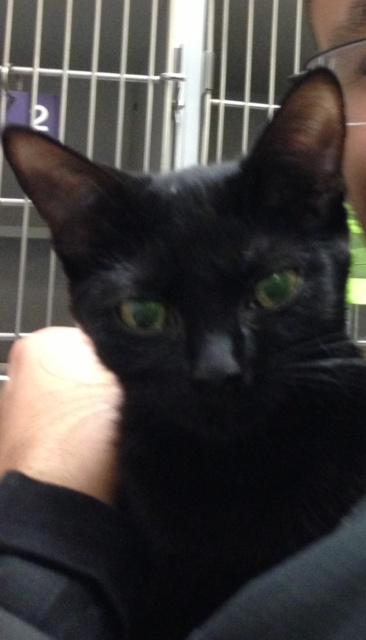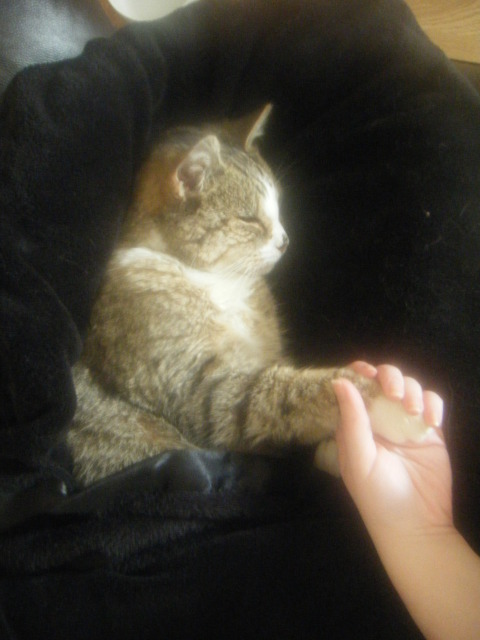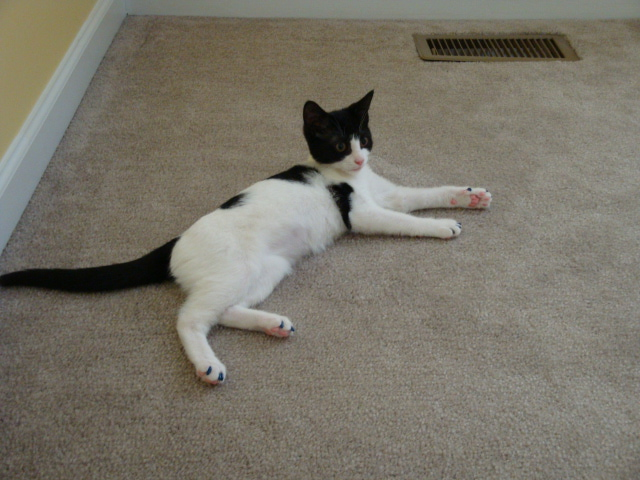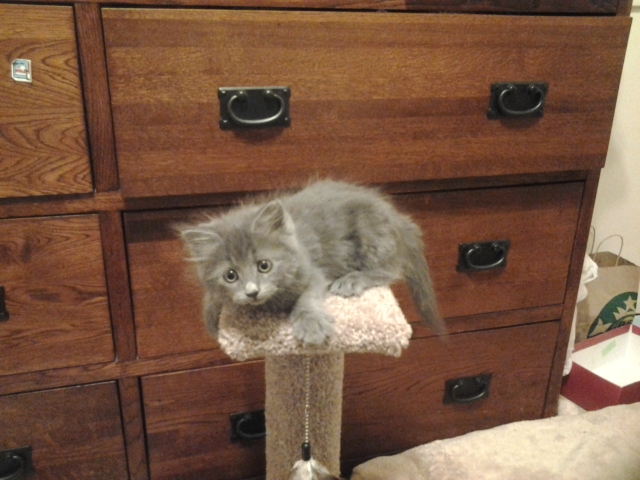QuestionQUESTION: Our mobile home park has threatened eviction as we let our feral cat roam, then return home to sleep and eat. We took her to a cat sacturary, she has been in a very large acclimation cage, for 7 weeks, has lost 2 lbs. and seems very depressed. We are now wanting to bring her back and keep her housed, maybe add another cat. She hates being in and looks for ways to escape. We can provide some outside with a fenced in area. She is precious, we love her she is about 4 years old and we have had her since she was about 5 months old. I don't think the sactuary will work, I think if they try to let her out of the cage, she will run away and die. It is very cold where she is, I am so worried and miss her and cannot stop crying. Will she finally adjust to the house if we bring her home, I need help. I can't sleep as I am so worried about her. Please advise. Thank you.
ANSWER: Hi Caroline,
I'm sorry you're going through such an ordeal, and just in time for the New Year!
How well a feral will warm up to human contact can be difficult to predict. Some will eventually become lap cats (literally), while others will scarcely let you touch them no matter how much time and effort you spend on them. But I CAN say one thing with 100% confidence - they adjust to the indoors absolutely fine. Every feral I've taken in has acclimated to the house even better than the domesticated cats I've had. After the initial "freak out" period, they really seem to understand they've got a place safe from predators, that's sheltered, even-temperatured and supplied with plenty of food and water. I can leave my doors wide open, and the ferals won't go near them. In fact, I have enclosed runs that my cats have 24-hour access to through cat doors, and some of the ferals will never set foot out in the runs as long as they live. Once they embrace their life indoors, they just can't be convinced to go back out!
I'm not sure what this one's personality has been like with you. If you haven't been able to pet her and hold her, that might not change much. Most ferals are rather set in their ways by her age, although I find most do continue to make some progress throughout life when one or two people work with them consistently. If she's a skiddish kitty, and you're fine with living with a cat who may never become cuddly, then by all means, bring her home. It will take her a few weeks to adjust to living in the home. She'll probably be frozen in one spot for a lot of that time, and move around only when the house is dark and quiet. In the worst cases, especially if there are lots of windows, some cats try to climb the walls. I know what a horrible feeling it is to see a kitty go through that fright. But she will adjust. It's important to sit tight through that difficult period - a happy, healthy cat awaits you in the near future!
You can encourage her to come out of her shell by using special food treats like chicken bits or dollops of chicken baby food. Also, leave a radio on playing classical music quietly. Classical music is shown to calm cats. It's preferred that any lighting in her area should be dim, and she should be limited to a small room at first. Once she adjusts, she can explore more of the home. I would disallow any outdoor access until she seems comfortable with the home.
Best of luck!
Jessica
---------- FOLLOW-UP ----------
QUESTION: Thank you soooo much for your quick response, I am feeling a bit better about the possibility of bringing her home from the sanctuary, it seems as if it would be definitely better to bring her home as the sanctuary people even said that usually they show a quicker response than 7 (now going on 8) weeks in the cage. question: What about introducing another cat? kitten, female? Katie is already used to our house and I am sure has not forgotten it yet. She also will go out on the porch, but as she can no longer roam the park, just wants to sleep all day. She does let us pick her up for a few minutes and will allow us to brush her. Maybe another cat would provide company for her. ??? Thanks!
AnswerI am a big proponant of keeping cats in the company of other cats. Studies show that cats who have kitty companions tend to be healthier overall. They tend to be healthier physically, because they encourage one another to exercise through play. They're healthier emotionally, because they provide normal nurturing behaviors toward one another, such as mutual grooming, leading to reduced anxiety levels, etc. They're healthier behaviorally, because they keep each other entertained, so they are less likely to engage in destructive behavior like scratching out of boredom. And they're healthier mentally, because their interactions with one another encourage each other to problem solve. In several countries, it's actually mandated that cats be kept with at least one other cat, citing cruelty to keep them isolated from their own kind.
However, I would recommend making one change at a time if possible. I would start with bringing her home, and then introduce a kitten a few weeks down the line. Kittens are easiest to introduce, but an adult cat with a known history of accepting cats can be great, too. Some people feel that male/female pairs bond most easily. I can't say this is my experience. As long as both cats are neutered, I haven't noticed any predisposition of either sex to gravitate toward one another (and I've worked with a LOT of cats!). It's more important for you to find a kitty that fits your personality than to worry about the sex.
At first, the two should be kept completely separate, and you should introduce them by scent transference. Rub one cat along the cheeks with a cloth, and allow the other to smell it. Then do the same with a clean cloth to the other cat. The two can become familiar by scent without fear of a confrontation. If you're working with a kitten, you can probably try introducing the two face to face in a day or two, but be prepared for them to hiss and growl. When this happens, see if feeding them some food treats several feet apart will make things better. Talk gently to them to reassure them that they're both nice kitties. The visit should end in 15 minutes if it goes well, or immediately if either kitty tries to chase or swat at the other. Try a visit again in a day or two if the first one goes poorly, but have several visits a day if it goes well, and increase the length each day until you feel comfortable leaving them together.
If you decide to go with an adult cat, you'll need to move more slowly, probably taking a couple of weeks to introduce them, and I'd recommend swapping their living spaces a couple times a day so that they can snoop each other out before meeting one another. Also, it can be helpful to feed them on opposite sides of a door, especially a glass or screen door if available.
Good luck!

 my cat had a kitten with one head and part of another with a mouth and has not nursed since she was born.
Question
my newborn kitten
my cat delivered a female ki
my cat had a kitten with one head and part of another with a mouth and has not nursed since she was born.
Question
my newborn kitten
my cat delivered a female ki
 Bombay at local pound??!
Question
Wide set eyes Kitten
Hi I have a
Bombay at local pound??!
Question
Wide set eyes Kitten
Hi I have a
 my old cat with no appetite
Question
Timmy since his loss o
Hi, Im really worried a
my old cat with no appetite
Question
Timmy since his loss o
Hi, Im really worried a
 Cat training/Runs away whenever downstairs
Question
Kairi in her room
Hi there!
I recently
Cat training/Runs away whenever downstairs
Question
Kairi in her room
Hi there!
I recently
 why does my kitten keep peeing on the bed
Question
My kitten
my 7-8 week old kitten has b
why does my kitten keep peeing on the bed
Question
My kitten
my 7-8 week old kitten has b